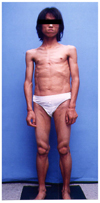Abstract
Acquired generalized lipodystrophy is a rare disease, and often follows autoimmune disease, prodromal infection, HIV infection. The clinical characteristics are generalized absence of fat, insulin resistance, diabetes mellitus, absence of ketosis, elevated basal metabolic rate, severe hypertriglyceridemia, and hepatomegaly. Here we experience and report a case of 16-year-old female patient who has clinical features of acquired generalized lipodystrophy with severe insulin resistant diabetes mellitus without any prodromal states.
Figures and Tables
References
1. Garg A. Lipodystrophies. Am J Med. 2000. 108:143–152.
2. Lawrence RD. Lipodystrophy and hepatomegaly with diabetes, report of 2 cases. Lancet. 1946. 1:724–731.
3. Beradinelli W. An undiagnosed endocrinometabolic syndrome: report of 2 cases. J Clin Endocrinol Metab. 1954. 14:193–204.
4. Seip M. Lipodystrophy and gigantism with associated endocrine manifestations; a new diencephaliic syndrome? Acta Paediatr. 1959. 48:555–574.
5. Garg A, Wilson R, Barnes R, Arioglu E, Zaidi Z, Gurakan F, Kocak N, O'Rahilly S, Taylor SI, Patel SB, Bowcock AM. A gene for generalized lipodystrophy syndrome 9q34. J Clin Endocrinol Metab. 1999. 84:3390–3394.
6. Anil K. AGPAT2 is mutated in congenital generalized lipodystrophy linked to chromosome 9q34. Nature Genetics. 2002. 31(1):21–23.
7. Mage J, Delepine M, Khallouf E, Gedde-Dahl T Jr, Van Maldergem L, Sobel E, Papp J, Meier M, Megarbane A, Bachy A, Verloes A, d'Abronzo FH, Seemanova E, Assan R, Baudic N, Bourut C, Czernichow P, Huet F, Grigorescu F, de Kerdanet M, Lacombe D, Labrune P, Lanza M, Loret H, Matsuda F, Navarro J, Nivelon-Chevalier A, Polak M, Robert JJ, Tric P, Tubiana-Rufi N, Vigouroux C, Weissenbach J. BSCL Working Group. Identification of the gene altered in Beradinelli-Seip congenital lipodystrophy on chromosome 11q13. Nat Genet. 2001. 28(4):365–370.
8. Gavrilova O, Marcus-Samuels B, Graham D, Kim JK, Shulman GI, Castle AL, Vinson C, Eckhaus M, Reitman ML. Surgical implantation of adipose tissue reverses diabetes in lipoatrophic mice. J Clin Invest. 2000. 105:271–278.
9. Randle PJ, Garland PB, Hales CN, Newsholme EA. The glucose fatty-acid cycle, its role in insulin sensitivity and the metabolic disturbances of diabetes mellitus. Lancet. 1963. 1:785–789.
10. Song S. The role of increased liver triglyceride content: a culprit of diabetic hyperglycemia. Diabetes Metab Res Rev. 2002. 18(1):5–12.
11. Kliewer SA, Sundseth SS, Jones SA, Brown PJ, Wisely GB, Koble CS, Devchand P, Wahli W, Willson TM, Lenhard JM, Lehmann JM. Fatty acids and eicosanoids regulate gene expression through direct interactions with peroxisome proliferator-activated receptors alpha and gamma. Proc Natl Acad Sci. 1997. 94:4318–4323.
12. Haque WA, Shinomura I, Matsuzawa Y, Garg A. Serum adiponectin and leptin level in patients with lipodystrophies. J Clin Endocrinol Metab. 2002. 87(5):2395.
13. Chinookoswong N, Wang JL, Shi ZQ. Leptin restores euglycemia and normalizes glucose turnover in insulin-deficient diabetes in the rat. Diabetes. 1999. 48:1487–1492.
14. Arioglu E, Dencan-Morin J, Sebring N, Rother KI, Glottieb N, lieberman J, Kleiner DE, Reynolds J, Premkumar A, Summer AE, Hoofnagle J, Tyalor SI. Efficacy and safety of troglitazone in the treatment of lipodystrophy syndromes. Ann inter Med. 2000. 133:263–274.
15. Petersen KF, Oral EA, Dufour S, Befroy D, Ariyan C, Yu C, Cline GW, DePaoli AM, Taylor SI, Gorden P, Shulman GI. Leptin reverses insulin resistance and hepatic steatosis in patients with severe lipodystrophy. J Clin Invest. 2002. 346:570–578.




 PDF
PDF ePub
ePub Citation
Citation Print
Print





 XML Download
XML Download